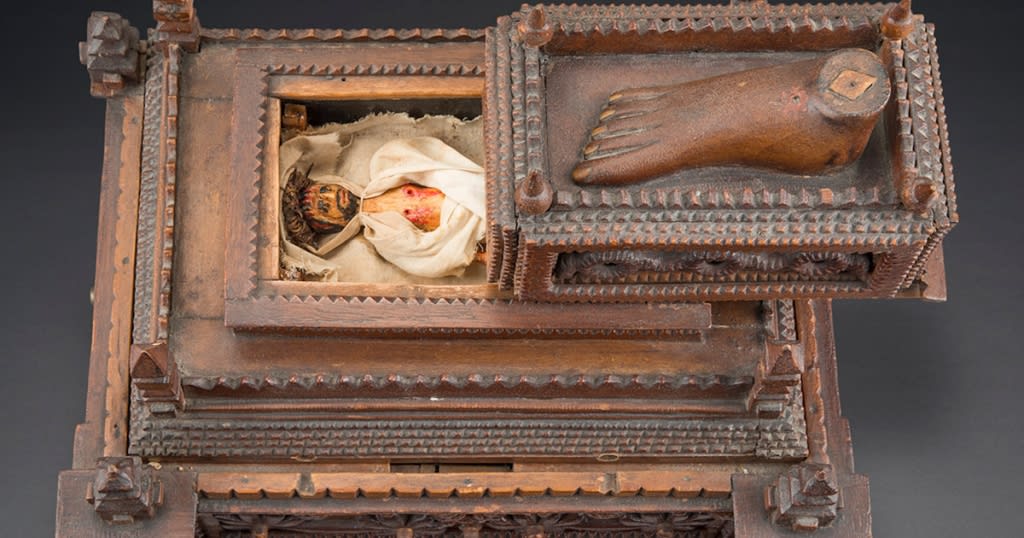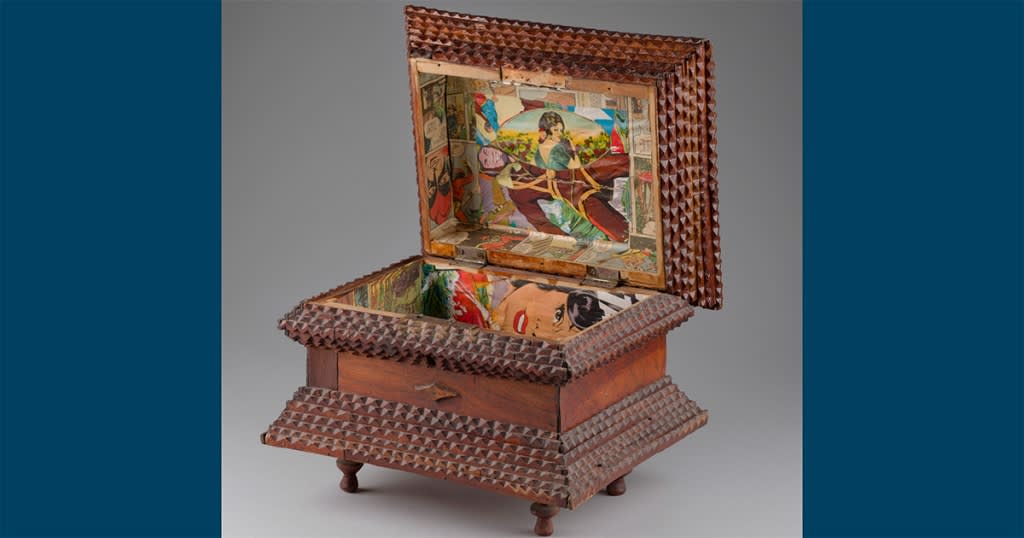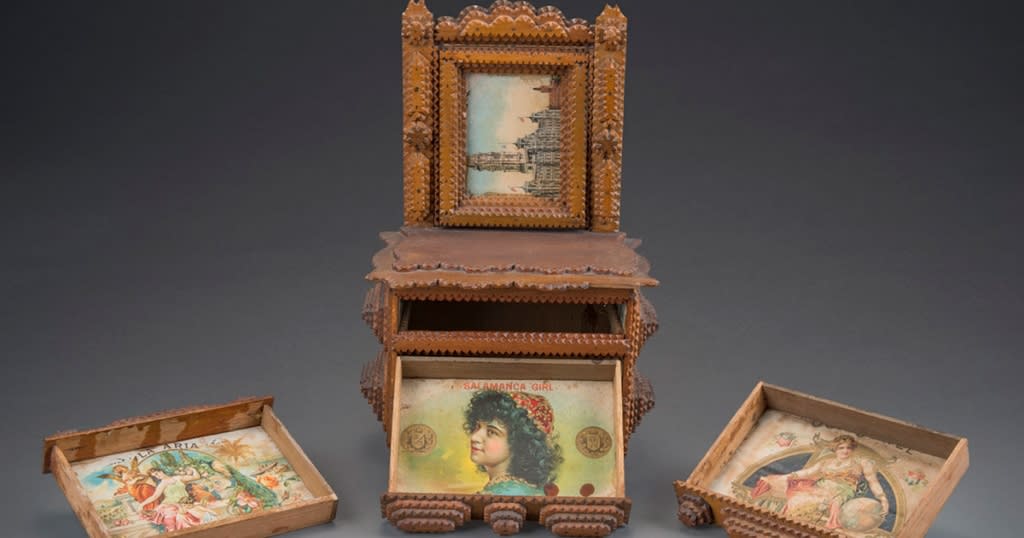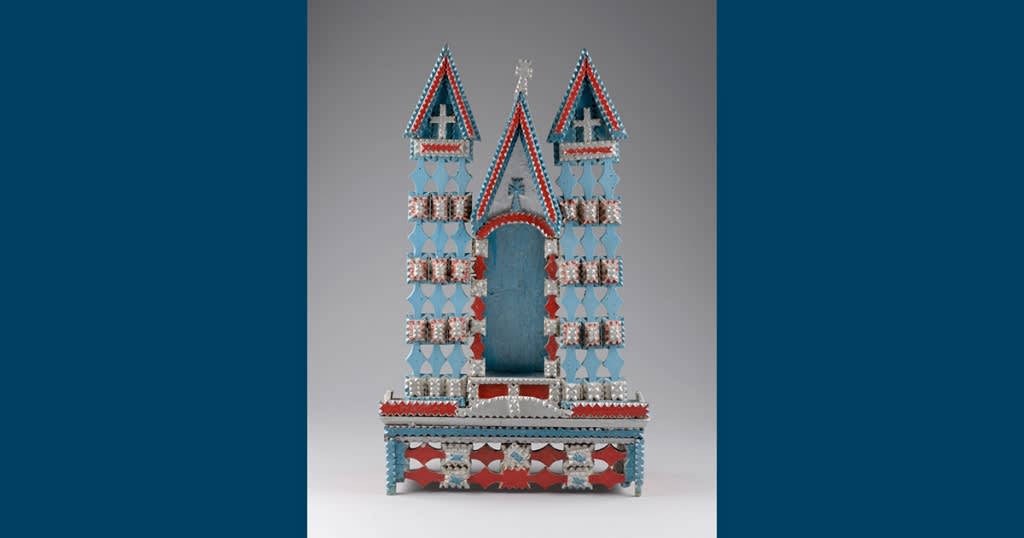Tramp art is a style of chip carving woodwork with recycled materials. Tramp art utilizes recycled wood scraps (i.e. discarded picture frames, cigar boxes) which are then crafted into works of art. It was a popular art form from the 1870s to the mid-1900s.
Here’s how Dictionary.com defines tramp art:
Here’s how Dictionary.com defines tramp art:
Folk art of the 19th and 20th centuries utilizing recycled found materials, as cedar or mahogany cigar boxes, shaped into containers, lamps, picture frames, or other objects by a technique involving the gluing or nailing together of successive thin layers of wood that are then whittled into intricate geometric designs to produce a protruding multifaceted surface.
While tramp art was made around the world, it was most popular in the United States. The most common forms of tramp art were the box and the frame, but tramp art took many forms and sizes including some full-sized furniture.
One of the best ways to become familiar with tramp art is by examining a tramp art exhibit that took place at the Museum of International Folk Art in Santa Fe, New Mexico.
One of the best ways to become familiar with tramp art is by examining a tramp art exhibit that took place at the Museum of International Folk Art in Santa Fe, New Mexico.
Santa Fe Tramp Art Exhibit
In 2017, the Museum of International Folk Art featured a major tramp art exhibit titled, “No Idle Hands: The Myths & Meanings of Tramp Art.” Featured in the exhibit were more than 150 tramp art examples from the United States, Canada, Germany, Mexico, Brazil, Switzerland, Scandinavia, and France.
According to the Museum of International Folk Art, this was the first large-scale museum exhibition dedicated to tramp art since 1975. The exhibit went a step further, however, by tackling the controversy, myth, and false perceptions that surround the world of tramp art.
Tramp art used to be a trending artistic movement where small pieces of wood, usually from old cigar boxes and crates used for shipping, were notch-carved along the edges then layered into objects. It is described as a type of “chip-carving woodwork.” The movement was mainly practiced in the United States and Europe from the 1870s to the 1940s.
According to the Museum of International Folk Art, this was the first large-scale museum exhibition dedicated to tramp art since 1975. The exhibit went a step further, however, by tackling the controversy, myth, and false perceptions that surround the world of tramp art.
Tramp art used to be a trending artistic movement where small pieces of wood, usually from old cigar boxes and crates used for shipping, were notch-carved along the edges then layered into objects. It is described as a type of “chip-carving woodwork.” The movement was mainly practiced in the United States and Europe from the 1870s to the 1940s.
“The ingenious objects in the Tramp Art exhibition use recycled or repurposed wood, and highlight a moment in time a century ago when artisans, many of them immigrants to the US, created a new variety of folk art,” says the Director of the Museum for International Folk Art, Khristaan D. Villela. “They are a testament to the ability of untrained artists to produce objects of immense beauty and complexity.”
Tramp Art got its name from the belief that itinerants and hobos were responsible for the creations and movement. According to the Museum of International Folk Art, “It has been demonstrated, however, that this belief, first put in print by Frances Lichten in a 1959 Pennsylvania Folklife article, is erroneous. Nonetheless, the name ‘tramp art’ has remained the only terminology used for this practice, and the paucity of scholarly studies to dispel the mistaken notions about tramp art have allowed the myths to persist.”
“Tramp art’s place in art history has been troublesome,” says Laura Addison, Curator of North American and European Folk Art at the Museum of International Folk Art. “It has had detractors—people who regard it as ’the ugly duckling’ of folk art—but also numerous champions. This exhibition will erase any doubts about the quality and craftsmanship of the work and situate tramp art as a practice at the crossroads of cultural transformation at the turn of the 20th century.”
The No Idle Hands exhibit displayed tramp art objects from four primary areas:
- Introduction/historical context
- home & nation
- frames & boxes
- devotional objects.
The Museum of International Folk Art is located on Museum Hill in Santa Fe, New Mexico. The tramp art exhibit concluded in 2018.
Tramp Art Images
Here are some photos of Tramp Art from the exhibit at the Museum of International Folk Art.

Degendt, Tramp art devotional box with Christ in Sepulchre and Arma Christi (probably Germany), 1884, wood, cotton, metal, paint, 14 3/8 x 12 13/16 x 8 ½ in. Museum of International Folk Art, IFAF Collection, gift of Eric Zafran. Photo: Blair Clark.

Tramp art keepsake box with comic-lined interior (Brazil), early 20th century, wood, paper, 9 7/16 x 12 ¼ x 4 in. Courtesy of Laurent Sozzani, Amsterdam. Photo: Margareta Svensson

Tramp art miniature dresser, deconstructed (United States), early 20th century, wood, paper, metal, 14 3/8 x 9 ¼ x 6 11/16 in. IFAF Collection, gift of Helene and David Mintz (FA.2016.25.5). Photo: Blair Clark.

Polychrome tramp art church or nicho (possibly New Mexico or Mexico), early 20th century, wood, paint, 23 5/8 x 14 ¼ x 5 ½ in. Courtesy of Laurent Sozzani, Amsterdam. Photo: Margareta Svensson.
Tramp art guitar photo at top of page by Carrie Haley.